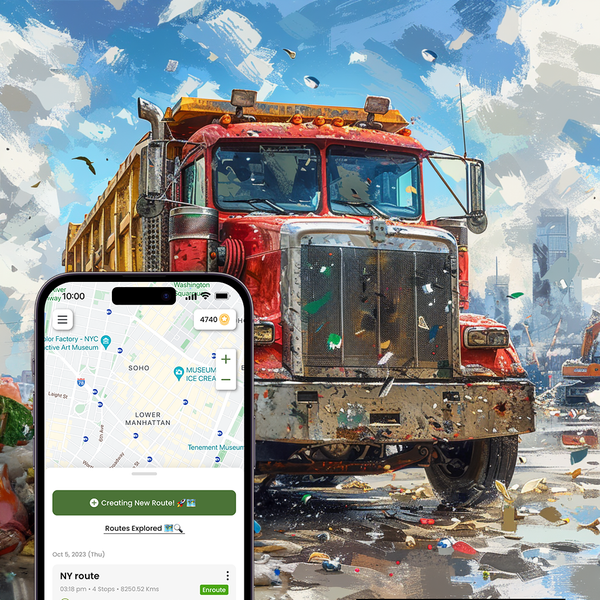As businesses navigate the challenges of rising fuel costs and increasingly tight delivery schedules, maximizing efficiency has transitioned from a competitive advantage to an essential requirement.
This is where route optimization comes into play, offering a powerful solution to these pressing issues. Route optimization involves much more than simply calculating the shortest distance between two or more points; it leverages advanced algorithms and real-time data to identify the most efficient routes. This process takes into account various external factors, including traffic conditions, vehicle capacity, and weather influences.
In this blog post, we will delve into the benefits of route optimization for businesses in 2024, highlight the latest advancements in this field, and provide practical guidance on how to implement these strategies effectively to drive your company's success.
Understanding Route Optimization
Definition and Core Concepts
Route optimization is the process of planning the most efficient travel paths for multiple destinations. It involves analyzing various factors such as traffic conditions, distances, and the order of stops to create the fastest and most cost-effective routes for drivers. This process is akin to using an advanced GPS system that not only finds the shortest path but also considers real-world variables like delivery windows, vehicle capacities, and road restrictions.
Key Terminology Explained
- Route Optimization: The method of determining the most cost-efficient routes while considering multiple stops and constraints.
- Algorithms: Computational methods used to evaluate numerous route possibilities, often employing techniques like dynamic programming to find optimal solutions efficiently.
- Real-Time Data Integration: The ability to adjust routes dynamically based on current traffic conditions and other external factors
Importance for Modern Businesses
Route optimization is crucial for businesses as it leads to significant cost savings on fuel and driver time. By ensuring timely deliveries and accurate arrival windows, companies can enhance customer satisfaction and operational efficiency. This optimization process allows businesses to handle complex routing scenarios that would be impractical through manual planning, especially as delivery demands increase
Industry-Specific Applications
- Logistics and Delivery Services: Companies utilize route optimization software to streamline operations, reduce delivery times, and improve overall service quality.
- Field Services: Businesses in sectors like maintenance or repair can optimize their service routes to minimize travel time between appointments, thereby increasing productivity.
- E-commerce: Online retailers leverage route optimization to ensure timely deliveries, which is essential for maintaining customer trust and satisfaction
Benefits Across Sectors
The advantages of implementing route optimization are multifaceted:
- Cost Reduction: Decreases in fuel consumption and vehicle wear due to optimized routes can lead to substantial savings.
- Increased Efficiency: Optimized routing allows businesses to handle more deliveries in less time, maximizing resource utilization.
- Enhanced Customer Experience: Improved accuracy in delivery times contributes to higher customer satisfaction levels.
By understanding these key concepts and their applications, businesses can effectively implement route optimization strategies that enhance operational efficiency and drive profitability.
The Benefits of Route Optimization in 2024
In 2024, efficiency is paramount. With rising fuel costs putting pressure on profit margins and customers demanding faster, more convenient service, businesses must find ways to do more with less. This is where route optimization becomes essential. By utilizing advanced software to determine the best travel routes, companies can significantly reduce costs while enhancing customer satisfaction. Let’s explore some of the key benefits of route optimization in 2024:
Cost Reduction and Efficiency
Route optimization software enables businesses to maximize their fuel budgets by minimizing travel distances and avoiding congested areas. This leads to substantial reductions in fuel consumption, resulting in lower operational costs and improved profitability.
Examples of Cost Savings
For instance, a logistics company that implemented route optimization saw a decrease in overall fuel expenses by 15%, allowing them to reallocate those savings towards other operational needs. Additionally, by optimizing delivery routes, businesses can increase the number of stops made per trip, further enhancing their bottom line.
Sustainability and Environmental Impact
Incorporating route optimization not only benefits the financial aspect but also supports eco-friendly initiatives. By reducing unnecessary mileage, businesses can significantly lower their carbon footprint.
Reducing Carbon Footprint
A study revealed that companies employing route optimization strategies reduced their emissions by up to 20%, contributing to a more sustainable operation while appealing to environmentally conscious consumers.
Enhancing Customer Experience
Customer satisfaction is a critical component of business success. Route optimization ensures timely deliveries and accurate arrival estimates, which are essential for keeping customers happy.
Real-World Case Studies of Route Optimization
Here are some real-world case studies showcasing how various companies across different industries have effectively implemented route optimization strategies:
1. Amazon
Amazon has long been a leader in logistics and delivery optimization. By adopting advanced route optimization technology, the company improved its delivery accuracy by 30%. This enhancement not only led to increased customer satisfaction but also resulted in higher repeat business, as customers appreciated the reliability of timely deliveries. Amazon's use of machine learning algorithms allows it to analyze vast amounts of data, adjusting routes in real-time based on traffic conditions and customer demand.
2. UPS
United Parcel Service (UPS) implemented its "ORION" (On-Road Integrated Optimization and Navigation) system, which uses advanced algorithms to determine the most efficient delivery routes. ORION has helped UPS save millions of gallons of fuel annually by minimizing left turns and optimizing delivery paths. As a result, UPS has reported a significant reduction in carbon emissions and improved operational efficiency, allowing drivers to complete more deliveries with less fuel consumption.
3. FedEx
FedEx employs route optimization through its proprietary software that analyzes package delivery data and traffic patterns. The company utilizes real-time data to adjust routes dynamically, ensuring that packages are delivered on time while minimizing fuel costs. FedEx's commitment to sustainability is evident in its efforts to reduce its carbon footprint, with route optimization playing a crucial role in achieving this goal.
4. Coca-Cola
Coca-Cola implemented route optimization software to enhance its distribution efficiency. By analyzing delivery routes and customer demand, Coca-Cola was able to reduce the number of miles driven by its delivery trucks. This not only saved on fuel costs but also improved service levels by ensuring timely deliveries to retailers. The company reported a significant decrease in operational costs as a direct result of these optimizations.
5. PepsiCo
PepsiCo adopted route optimization tools to streamline its supply chain logistics. The company utilized software that integrates with its existing systems to analyze delivery patterns and optimize routes for its fleet. By doing so, PepsiCo achieved a reduction in transportation costs and improved delivery efficiency, allowing it to respond more quickly to customer needs.
6. Home Depot
Home Depot implemented route optimization strategies for its home delivery services. By using advanced routing software, the company was able to reduce delivery times and improve customer satisfaction. The integration of real-time traffic data allowed Home Depot to adjust routes on-the-fly, ensuring that deliveries were made within promised time frames.
Conclusion
These case studies illustrate the diverse applications of route optimization across various industries. Companies like Amazon, UPS, FedEx, Coca-Cola, PepsiCo, and Home Depot have demonstrated how leveraging advanced technologies can lead to significant cost savings, enhanced efficiency, and improved customer experiences. As businesses continue to navigate challenges such as rising fuel costs and increasing customer expectations, implementing effective route optimization strategies will be essential for maintaining a competitive edge in the market.
Implementing Route Optimization in Your Company
Ready to harness the power of route optimization and transform your business operations? Here’s a roadmap to guide you through the implementation process:
Step-by-Step Guide
Getting Started
The first step is to assess your company's specific needs for effective route planning. Consider the following factors:
- Delivery Type: Are you handling multiple small packages, bulky items, or time-sensitive deliveries?
- Service Area Size: Is your service area concentrated in an urban center or spread across a rural region?
- Customer Requirements: Do your customers have specific delivery windows or require special handling for their deliveries?
By understanding these unique needs, you can select a route planner app that effectively addresses your challenges and optimizes routes for your context.
Tools and Technologies
Choosing the right route optimization software is crucial. The market offers various solutions, from free basic versions to feature-rich paid options. Here are key factors to consider when evaluating your options:
- Features Offered: Does the software provide essential functionalities such as real-time traffic updates and multi-stop optimization?
- Ease of Use: Is the software user-friendly for both dispatchers and drivers?
- Scalability: Can the software accommodate your current and future delivery volumes?
- Cost: Compare pricing models and features to find the best value for your budget.
Comparison of Leading Software
Here’s a comparison of some leading route optimization software options:
| Software | Key Features | Best For |
|---|---|---|
| Upper | User-friendly interface, handles up to 500 addresses | Small to mid-sized businesses |
| Routific | Last-mile delivery focus, multi-stop route planning | Small and mid-sized businesses |
| Route4Me | Powerful route optimization, scalability | Businesses of all sizes |
| OptimoRoute | Automated scheduling, live driver monitoring | Field service and delivery |
| Onfleet | Real-time tracking, customer notifications | Mid-market and enterprise |
Overcoming Common Challenges
Implementing route optimization can present challenges, but with the right strategies, you can overcome them effectively.
Expert Tips and Solutions
- Seamless Integration with Current Systems: Ensure that your chosen route optimization app integrates smoothly with existing business systems such as CRM software, order management systems, or accounting software. This integration will streamline operations and improve data flow.
- Employee Training for Optimal Route Usage: Successful implementation relies on buy-in from your team. Provide comprehensive training for dispatchers on how to use the software effectively to create and manage optimized routes. Additionally, train drivers on utilizing mobile app functionalities for navigation and understanding the importance of following optimized routes.
- Monitor and Adjust as Needed: After implementation, continuously monitor the performance of your route optimization system. Gather feedback from drivers and dispatchers to identify areas for improvement. Be prepared to make adjustments based on changing business needs or operational challenges.
By following these steps, you can effectively implement route optimization in your company and unlock a world of benefits—propelling your business toward greater efficiency, cost savings, and ultimately, happier customers.
Metrics for Success
Measuring the success of route optimization efforts is crucial for businesses to understand the impact of their strategies. Here are key performance indicators (KPIs) that companies can use to evaluate their route optimization initiatives:
Key Performance Indicators (KPIs)
- Delivery Times: Track the average time taken for deliveries before and after implementing route optimization. A reduction in delivery times indicates improved efficiency.
- Fuel Savings: Measure the decrease in fuel consumption as a result of optimized routes. This can be quantified by comparing fuel usage over specific periods before and after optimization.
- Customer Satisfaction Scores: Utilize customer feedback and surveys to gauge satisfaction levels regarding delivery timeliness and overall service quality. Higher satisfaction scores post-implementation reflect the effectiveness of route optimization.
- Operational Costs: Analyze changes in operational costs related to transportation and logistics. A reduction in costs can signify successful route optimization.
- Delivery Accuracy: Monitor the percentage of deliveries made on time. An increase in delivery accuracy demonstrates the positive impact of optimized routing on service reliability.
Integration with Other Business Functions
Integrating route optimization with other business functions can significantly enhance overall operational efficiency. Here are key areas where route optimization can be effectively integrated:
Inventory Management
- Route optimization can be aligned with inventory management systems to ensure that delivery schedules are synchronized with stock levels. By analyzing inventory data, companies can optimize routes based on product availability, reducing delays and improving service levels.
Customer Relationship Management (CRM)
- Integrating route optimization with CRM systems allows businesses to tailor delivery schedules based on customer preferences and historical data. This integration helps in providing more accurate delivery windows, enhancing customer satisfaction and loyalty.
Supply Chain Logistics
- Route optimization plays a crucial role in supply chain logistics by ensuring that transportation routes are aligned with supplier schedules and demand forecasts. This alignment reduces lead times and enhances the efficiency of the entire supply chain.
Challenges and Solutions
While implementing route optimization can lead to significant benefits, businesses may encounter various challenges during the process. Understanding these potential pitfalls and how to avoid them is crucial for successful implementation.
Common Challenges in Implementation
- Resistance to Change: Employees may be hesitant to adapt to new technologies or processes. This resistance can hinder the adoption of route optimization software.
- Data Quality Issues: Inaccurate or incomplete data can lead to ineffective routing decisions. Ensuring high-quality data input is essential for optimal results.
- Integration Difficulties: Integrating route optimization software with existing systems (like CRM or inventory management) can be complex and may require additional resources.
- Lack of Training: Insufficient training for dispatchers and drivers on how to use the new software can result in underutilization of the system's capabilities.
- Overlooking Real-Time Adjustments: Failing to utilize real-time data for dynamic routing can negate the benefits of route optimization, as conditions may change rapidly.
Solutions to Overcome Challenges
- Foster a Culture of Change: Communicate the benefits of route optimization clearly and involve employees in the implementation process to encourage buy-in.
- Ensure Data Accuracy: Regularly audit and clean data inputs to maintain high standards of accuracy, which is critical for effective routing.
- Plan for Integration: Allocate resources for a smooth integration process, including IT support, to ensure that route optimization software works seamlessly with existing systems.
- Provide Comprehensive Training: Develop a robust training program that covers all aspects of the software for both dispatchers and drivers, ensuring they understand its functionalities.
- Utilize Real-Time Data: Implement systems that allow for real-time data integration so that routes can be adjusted dynamically based on current conditions, maximizing efficiency.
Recent Advancements in Route Optimization for 2024
The world of route optimization is continuously evolving, with innovative technologies being integrated to enhance efficiency and sustainability. Here’s an overview of the exciting advancements in route optimization for 2024:
Innovations and Developments
As businesses strive to improve their logistics and delivery operations, several key innovations are transforming route optimization. These advancements go beyond traditional methods, incorporating cutting-edge technologies to create smarter systems.
Impact of AI and Machine Learning
Artificial intelligence (AI) is at the forefront of these innovations, enabling dynamic route adjustments in real-time based on unexpected traffic conditions or incidents. AI algorithms analyze a wide range of data, including real-time traffic, weather conditions, vehicle capacity, and delivery constraints. This allows for highly optimized routes that not only save time but also reduce fuel consumption.Machine learning (ML) enhances this process by analyzing historical data to predict future traffic patterns. This predictive capability enables route optimization software to anticipate congestion and adjust routes proactively, ensuring timely deliveries.
Future Trends to Watch
Looking ahead, several trends are emerging in route optimization that businesses should be aware of:
- Increased Automation: The integration of autonomous vehicles and delivery drones is set to revolutionize last-mile delivery. These technologies will streamline operations and reduce labor costs while enhancing delivery speed.
- Enhanced IoT Integration: The Internet of Things (IoT) will play a significant role in gathering real-time data from connected vehicles and infrastructure. This data will feed into optimization algorithms, allowing for even more precise routing decisions.
- Sustainability Initiatives: As environmental concerns grow, businesses will increasingly seek route optimization solutions that minimize emissions. Software that incorporates features for electric vehicle (EV) routing and optimizes for reduced fuel consumption will become essential.
- Real-Time Data Utilization: The ability to integrate real-time data into routing decisions will continue to improve. Companies will leverage live updates on traffic conditions, weather changes, and other factors to dynamically adjust routes as needed.
If you're ready to streamline your operations and unlock the full potential of your delivery or service network, take the first step today. Identify your needs, evaluate route optimization software options, and empower your team to utilize this powerful tool. By charting the most efficient course, you can ensure your business stays ahead of the curve and thrives in the years to come.
Future Outlook
As we look beyond 2024, the evolution of route optimization technology promises to bring even more transformative changes to logistics and delivery operations. Here are some potential trends and advancements to watch for in the coming years:
Increased Automation
- The integration of autonomous vehicles and drones is expected to revolutionize last-mile delivery. These technologies will streamline operations, reduce labor costs, and enhance delivery speed, allowing businesses to meet growing customer demands more effectively.
Enhanced Data Analytics
- Future route optimization solutions will likely leverage advanced data analytics capabilities. By analyzing vast datasets from various sources, businesses can gain deeper insights into traffic patterns, customer preferences, and operational efficiencies, leading to even more precise routing decisions.
Greater Emphasis on Sustainability
- As environmental concerns continue to rise, route optimization technologies will increasingly focus on sustainability. Companies will seek solutions that not only optimize routes for efficiency but also minimize carbon footprints by integrating electric vehicle (EV) routing and eco-friendly practices.
Real-Time Adaptability
- Future advancements will enable route optimization systems to adapt in real-time to changing conditions such as traffic incidents, weather changes, or last-minute customer requests. This adaptability will ensure that deliveries remain timely and efficient despite unforeseen circumstances.
Integration with Smart City Initiatives
- As smart city technologies develop, route optimization will become increasingly integrated with urban infrastructure. This integration will allow for better traffic management and coordination between delivery services and city planning efforts, enhancing overall logistics efficiency.
Conclusion: The Bottom Line for Businesses
In conclusion, route optimization is a critical aspect of efficient logistics management for businesses of all sizes. By leveraging advanced technologies such as AI, machine learning, and IoT integration, organizations can streamline their operations, reduce costs, minimize fuel consumption, and enhance overall productivity.
See how optimizing your unique operations with DynoRoute can impact your bottom line.
Start a free trial today.Let us help you take full advantage of technology, increase the visibility of your business, and focus your time on improving customer experiences.








